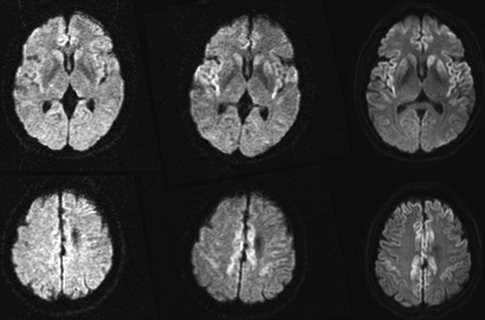J Korean Med Sci.
2011 Nov;26(11):1515-1517. 10.3346/jkms.2011.26.11.1515.
Dura Mater Graft-Associated Creutzfeldt-Jakob Disease: The First Case in Korea
- Affiliations
-
- 1Department of Neurology, Hallym University College of Medicine, Hallym University, Anyang, Korea. yunkim@hallym.ac.kr
- 2ILSONG Institute of Life Science, Hallym University, Anyang, Korea.
- 3Department of Neurosurgery, Hallym University College of Medicine, Hallym University, Anyang, Korea.
- 4Department of Radiology, Hallym University College of Medicine, Hallym University, Anyang, Korea.
- 5Department of Anesthesiology and Pain Medicine, Hallym University College of Medicine, Hallym University, Anyang, Korea.
- 6Department of Pathology, Hallym University College of Medicine, Hallym University, Chuncheon, Korea.
- 7Department of Microbiology, Hallym University College of Medicine, Hallym University, Chuncheon, Korea.
- 8Department of Neurology, National Reference Center for TSE, Goettingen, Germany.
- 9Department of Neuroradiology, University Medicine, Georg-August-University, Goettingen, Germany.
- KMID: 1123455
- DOI: http://doi.org/10.3346/jkms.2011.26.11.1515
Abstract
- Since 1987, dura mater graft-associated iatrogenic Creutzfeldt-Jakob disease (dCJD) has been reported in many countries. We report the first case of dCJD in Korea. A 54-yr-old woman, who underwent resection of the meningioma in the left frontal region and received a dura mater graft 23 yr ago presented with dysesthesia followed by psychiatric symptoms and ataxia. Her neurological symptoms rapidly progressed to such an extent that she exhibited myoclonus, dementia, and pyramidal and extrapyramidal signs within 8 weeks. The 14-3-3 protein was detected in her cerebrospinal fluid; however, an electroencephalogram did not reveal characteristic positive sharp wave complexes. Diffusion-weighted magnetic resonance images, obtained serially over 64 days, revealed the rapid progression of areas of high signal intensity in the caudate nucleus and cingulate gyrus to widespread areas of high signal intensity in the cortex and basal ganglia. Pathological examination of brain biopsy specimens confirmed the presence of spongiform changes and deposition of prion protein in the neurons and neuropils.
MeSH Terms
Figure
Cited by 1 articles
-
Neurologists' Awareness and Preparedness on Prion Diseases in Korea
Jae-Won Jang, Young Ho Park, Jae Sung Lim, Soo Chul Park, Hae-Kwan Cheong, Jung E. Kim, SangYun Kim
Dement Neurocogn Disord. 2013;12(1):9-20. doi: 10.12779/dnd.2013.12.1.9.
Reference
-
1. Brown P, Brandel JP, Preece M, Sato T. Iatrogenic Creutzfeldt-Jakob disease: the waning of an era. Neurology. 2006. 67:389–393.2. Thadani V, Penar PL, Partington J, Kalb R, Janssen R, Schonberger LB, Rabkin CS, Prichard JW. Creutzfeldt-Jakob disease probably acquired from a cadaveric dura mater graft. Case report. J Neurosurg. 1988. 69:766–769.3. Tintner R, Brown P, Hedley-Whyte ET, Rappaport EB, Piccardo CP, Gajdusek DC. Neuropathologic verification of Creutzfeldt-Jakob disease in the exhumed American recipient of human pituitary growth hormone: epidemiologic and pathogenetic implications. Neurology. 1986. 36:932–936.4. Hogan RN, Cavanagh HD. Transplantation of corneal tissue from donors with diseases of the central nervous system. Cornea. 1995. 14:547–553.5. Simpson DA, Masters CL, Ohlrich G, Purdie G, Stuart G, Tannenberg AE. Iatrogenic Creutzfeldt-Jakob disease and its neurosurgical implications. J Clin Neurosci. 1996. 3:118–123.6. Bryce EA, Dorovoni-Zis K, Trudeau D, Sinclair M, Roberts FJ. Creutzfeldt-Jakob disease: management of accidental contamination of neurosurgical instruments, pathology equipment, and solutions. Infect Control Hosp Epidemiol. 2000. 21:247–248.7. Heath CA, Barker RA, Esmonde TF, Harvey P, Roberts R, Trend P, Head MW, Smith C, Bell JE, Ironside JW, Will RG, Knight RS. Dura mater-associated Creutzfeldt-Jakob disease: experience from surveillance in the UK. J Neurol Neurosurg Psychiatry. 2006. 77:880–882.8. Brooke FJ, Boyd A, Klug GM, Masters CL, Collins SJ. Lyodura use and the risk of iatrogenic Creutzfeldt-Jakob disease in Australia. Med J Aust. 2004. 180:177–181.9. Noguchi-Shinohara M, Hamaguchi T, Kitamoto T, Sato T, Nakamura Y, Mizusawa H, Yamada M. Clinical features and diagnosis of dura mater graft associated Creutzfeldt Jakob disease. Neurology. 2007. 69:360–367.10. Yamada M, Noguchi-Shinohara M, Hamaguchi T, Nozaki I, Kitamoto T, Sato T, Nakamura Y, Mizusawa H. Dura mater graft-associated Creutzfeldt-Jakob disease in Japan: clinicopathological and molecular characterization of the two distinct subtypes. Neuropathology. 2009. 29:609–618.11. Meissner B, Kallenberg K, Sanchez-Juan P, Ramljak S, Krasnianski A, Heinemann U, Eigenbrod S, Gelpi E, Barsic B, Kretzschmar HA, Schulz-Schaeffer WJ, Knauth M, Zerr I. MRI and clinical syndrome in dura mater-related Creutzfeldt-Jakob disease. J Neurol. 2009. 256:355–363.12. Yamada M, Nozaki I, Hamaguchi T, Noguchi-Shinohara M, Kitamoto T, Nakamura Y, Sato T, Mizusawa H. Prion disease surveillance in Japan: analysis of 1,241 patients. Rinsho Shinkeigaku. 2009. 49:939–942.13. Centers for Disease Control and Prevention (CDC). Update: Creutzfeldt-Jakob disease associated with cadaveric dura mater grafts: Japan, 1979-2003. MMWR Morb Mortal Wkly Rep. 2003. 52:1179–1181.14. Nakamura Y, Yanagawa H, Hoshi K, Yoshino H, Urata J, Sato T. Incidence rate of Creutzfeldt-Jakob disease in Japan. Int J Epidemiol. 1999. 28:130–134.
- Full Text Links
- Actions
-
Cited
- CITED
-
- Close
- Share
- Similar articles
-
- A case of Creutzfeldt-Jakob disease
- Estimation of the size of the iatrogenic Creutzfeldt-Jakob disease outbreak associated with cadaveric dura mater grafts in Korea
- New Variant Creutzfeldt-Jakob Disease
- A Case of Probable Creutzfeldt-Jakob Disease with Coexistence of the Features of Hashimoto Encephalopathy
- Creutzfeldt-Jakob Disease Mimicking a Stroke as Initial Manifestation



